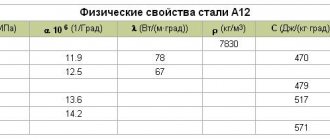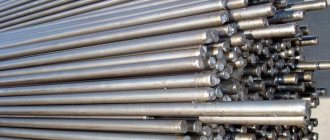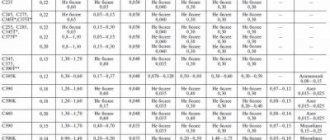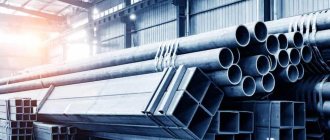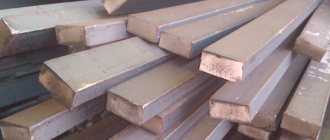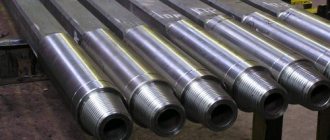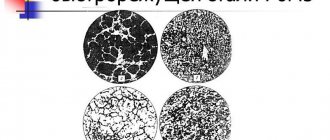| Brand: | 9ХС |
| Class: | Alloy tool steel |
| Used for rental: | Long and shaped steel: GOST 5950-2000, GOST 2590-2006, GOST 2591-2006. Calibrated rod GOST 5950-2000, GOST 7417-75, GOST 8559-75, GOST 8560-78. Polished rod and silver steel GOST 5950-2000, GOST 14955-77. Strip GOST 5950-2000, GOST 4405-75. Forgings and forged blanks GOST 5950-2000, GOST 1133-71 |
| Industrial use: | Manufacturing of drills, reamers, taps, dies, combs, cutters, machine dies, stamps for cold work. Critical parts, the material of which must have increased wear resistance, fatigue strength during bending, torsion, contact loading, as well as elastic properties. |
| Heat treatment: | Delivery status |
| Material hardness: | HB 10-1 = 241 MPa |
| Critical point temperature: | Ac1 = 770, Ac3(Acm) = 870, Ar1 = 730, Mn = 160 |
| Forging temperature, °C: | °C: beginning 1180, end 800. Sections up to 200 mm are cooled in the well |
| Cutting ability: | In the hot-rolled state at HB 221, Kυ tv. spl = 0.9 and Kυ b.st = 0.5 |
| Weldability of material: | Not applicable for welded structures |
| Flock Sensitivity: | Not sensitive |
| Tendency to temper brittleness: | Inclined |
| Analogues: | HVG, HVSG |
Decoding
- The number 9 indicates that the steel contains 0.9% carbon;
- The letter X indicates the presence of Chromium (Cr) in the steel; the absence of a number after the letter means that the % Chromium content is on average no more than 1.5% (in this steel, Chromium is 0.95 - 1.25%);
- The letter C indicates the presence of Silicon (Si) in the steel; the absence of a number after the letter means that the % Silicon content is on average no more than 1.5% (in this steel there is 1.2 - 1.6% Silicon);
What knives is it used for?
9ХС steel is widely used for the manufacture of knife blades. No special equipment is required to give the alloy the desired shape, which is why knife makers love this brand.
Knives made of 9ХС steel are most often purchased for tourism, hunting, and fishing. They cope remarkably well with the tasks that arise in traveling conditions. Thanks to the special 9XC alloy, the knives are highly durable. It is able to withstand significant loads: impacts, torsion, contact loading.
Knife Marten 24.5 cm - 8100 rub.
One of the most important characteristics for a tourist or hunting knife is good cutting properties. Blades made of 9ХС steel can easily cut hard objects, such as tree branches or animal bones, and are suitable for cutting carcasses. They tolerate aggressive environmental conditions well and are not afraid of water and high temperatures. Although, due to the insufficiently high percentage of chromium in the composition, they cannot be classified as stainless.
Chemical composition of 9ХС steel
| Chemical element | % |
| Carbon (C) | 0,85 – 0,95 |
| Silicon (Si) | 1,2 – 1,6 |
| Manganese (Mn) | 0,3 – 0,6 |
| Nickel (Ni) | up to 0.4 |
| Phosphorus (P) | up to 0.03 |
| Chromium (Cr) | 0,95 – 1,25 |
| Molybdenum (Mo) | up to 0.2 |
| Tungsten (W) | up to 0.2 |
| Vanadium (V) | up to 0.15 |
| Titanium (Ti) | up to 0.03 |
| Sulfur (S) | up to 0.03 |
| Copper (Cu) | up to 0.3 |
| Iron (Fe) | ~94 |
Tool hard alloys.
Hard alloys of standard grades are made on the basis of tungsten, titanium and tantatle carbides. Cobalt is used as a binder. Depending on the composition of the carbide phase and the binder, the designation of hard alloys includes letters characterizing the carbide-forming elements (B-tungsten, T-titanium, the second letter is T-tantalum) and the binder (K-cobalt). Mass fractions of elements are expressed as percentages, the sum of which is 100%. For example, grade VK8 (single-carbide alloy) contains 8% cobalt and 92% tungsten carbides; grade T5K10 (two-carbide alloy) contains 5% titanium carbides, 10% cobalt and 85% tungsten carbides; grade TT8K6 (three-carbide alloy) contains 6% cobalt, 8% titanium and tantalum carbides, 86% tungsten carbides.
Basic physical and mechanical properties of hard alloys
Good day. Tell me what is the difference between high-speed steels R9 and R6M5 if they are used for a knife blank. The thing is that at the bazaar I found a semi-bald industrial metal saw with P9 markings, 2.3 thick, the owner said that it was still a Soviet one - so I’m thinking about whether to take it or not?
it goes without saying! But about what is better P9 or P6M5? Of course it is clear that both will shave.
Almost any piece of iron will shave if properly sharpened.
Take any good material.
ASDER_K Who are you commenting on? me or the author. if me, then I didn’t say that
kick, kick and kick some more gas. If you see a Soviet saw made from R18, definitely take it.
They give you a chance to take it. p9 is more fragile. in p6m5 there is 5 percent molybdenum, which is gut.
Nothing good will come of it at home, 500 degrees for a quick cut is a normal temperature. The fragility of quick cutters is greatly exaggerated; it works great on small blades. I made several blades from P6M5 with very thin bevels, they all seem to be intact and they cut great. P9 does not I tried it, the P18 is really fragile, the tip of the blade on the working jamb broke several times under lateral loads.
rumors about the fragility of quick-cutters are greatly exaggerated - that’s for sure. Just how thin the rockstead is, even though it’s in a lens, it doesn’t crumble)
There are no rumors about the fragility of quick cutters. p6m5 in canvas is quite a good steel. on small knives with a blade up to 150 mm, nothing seems to happen to it. But the R-18 crumbles well, I have experience with the R-9 too. It just depends on what you do with the knife and what the geometry of the wedge is. but, with the cost of a saw blade being 50 rubles, which is enough for 2 medium-sized knives, issues of fragility can be considered minor. for example, what will happen to the ZDP-189 and other steels of this class if, with the geometry of half razor blades from 0.5 in the RK and the blade length of the same 150 mm, it chops firewood or cuts meat with chopping bones?
nothing special either, especially if it’s 0.5 on the Republic of Kazakhstan. checked (although of course it was only 90mm) but this does not fundamentally change the situation.
If possible, I prefer to take saws that have already worked. There are two reasons - they are somewhat cheaper than new ones and, most importantly, the quality of the metal can be seen from the signs of wear. If the blade does not move during operation, there are no spilled teeth, then there are no hidden cracks or overheating.
Mechanical properties of 9ХС steel
| Delivery condition, heat treatment mode | Section, mm | Conditional yield strength, MPa | Tensile strength, MPa | Relative narrowing, % | Impact strength, (kJ/m2) | Brinell hardness, no more |
| Isothermal annealing 790-810°C. Isothermal holding temperature 710°C | — | 295-390 | 590-690 | 50-60 | — | 197-241 |
| Hardening 870°C, oil. Vacation*: | ||||||
| 180-240°С | up to 40 | — | — | — | 78 | 59-63 |
| 450-500°С | up to 30 | — | — | — | — | 46-50 |
* — tempering temperature is recommended for collets and other spring-type parts, as well as loaded shafts.
Analogs
If you don’t delve too deeply into the definition, then U10A-7KhNM can be considered Damascus steel, at least it has quite a lot in common with them.
This means that this broad subspecies of metals can be considered its analogues. In terms of its properties, ZD-0803 is very similar to U10A-7ХНМ. It also combines high cutting performance, resistance to heavy loads, but requires simple maintenance. Its hardening is also within 59-60 HRC.
Another analogue, the characteristics of which are also somewhat reminiscent of the U10A-7ХНМ, is 40Х13-Х12Ф1. This is a high-alloy steel grade of increased hardness. Used for cutting, measuring tools, household items, items that require wear and tear, for example, springs, bearings, etc.). This is a popular steel with good corrosion resistance.
Previous SteelElmax steel: characteristics Next SteelSteel 9Cr18MoV
Mechanical properties of 9ХС steel at elevated temperatures
| Test temperature, °C | Conditional yield strength, MPa | Tensile strength, MPa | Relative elongation after rupture, % | Relative narrowing, % | Impact strength, (kJ/m2) | Brinell Hardness (HB) |
| Delivery status | ||||||
| 20 | 445 | 790 | 26 | 54 | 39 | 243 |
| 200 | 320 | 710 | 22 | 48 | 88 | 218 |
| 400 | 330 | 620 | 32 | 63 | 98 | 213 |
| 600 | 170 | 200 | 52 | 77 | — | 172 |
| 700 | 83 | 98 | 58 | 77 | 147 | — |
| Sample 10 mm in diameter, 50 mm long, rolled. Deformation speed 20 mm/min. Strain rate 0.007 1/s | ||||||
| 800 | 110 | 130 | 26 | 68 | — | — |
| 900 | 65 | 74 | 41 | 95 | — | — |
| 1000 | 42 | 46 | 52 | — | — | — |
| 1100 | 20 | 31 | 54 | — | — | — |
| 1200 | 15 | 20 | 83 | 100 | — | — |
Main characteristics
The performance qualities of almost any material largely depend on the chemical composition. The characteristics of 9xc were slightly changed by adding silicon and chromium to the alloying elements.
The characteristics of 9xs steel can be characterized as follows:
- A small concentration of chromium determines that the metal has an attractive appearance, as well as low corrosion resistance.
- Silicon increases structural strength and wear resistance.
- Low weldability. The presence of a sufficiently high concentration of silicon in the composition causes a decrease in weldability. Therefore, if it is necessary to connect two elements by welding, it is necessary to heat the structure.
- High tendency to temper brittleness. That is why heat treatment uses methods that reduce the likelihood of defects or increased brittleness.
The composition and structure features determine the high probability of broach deformation. To reduce the degree of defects, heat treatment is carried out in two stages: before machining and after finishing work.
Hardenability of steel 9ХС
| Steel hardening | ||||||||
| Distance from the end, mm | 5 | 10 | 20 | 25 | 30 | 40 | 50 | 60 |
| Hardness for hardenability strips, (Rockwell hardness, C scale) | 63 | 36,5 | 32 | 30 | 28 | 26 | 25 | 24 |
| Heat treatment | Critical diameter in oil, mm |
| Hardening | 15-50 |
Structural transformations during heat treatment.
We subject the steel to incomplete hardening and heat it until austenite and secondary cementite are formed. Next, we keep it at this temperature (840 ºС) to obtain homogeneous austenite.
Subsequent cooling in oil at a rate greater than Vcrit (lower cooling rate at which austenite turns into martensite) ensures the production of fine-grained martensite.
Let us consider the transformation in oil that occurs in 9ХС steel upon heating the initial equilibrium structure F+C. In practice, at normal heating rates (in an electric furnace) for hardening, pearlite retains its lamellar or granular structure up to the Ac1 temperature (770 ºС for 9ХС steel). At temperature Ac1 in steel, pearlite transforms into austenite. Austenite crystals (grains) nucleate mainly at the boundaries of the ferrite and cementite phases. The formation of austenite grains occurs at a faster rate than the dissolution of pearlite cementite, therefore it is necessary to hold the steel at the quenching temperature to completely dissolve cementite and obtain homogeneous austenite.
Changes in steel structure during oil quenching
.
During continuous cooling in steel with Vcool > Vcrit, austenite transforms into martensite. Martensitic transformation develops in steel at a high speed (1000-7000 m/s) in the temperature range Mn...Mk. It is necessary to take into account that with an increase in the carbon content in steel, the temperatures Mn and Mk decrease (points Mn and Mk change their position on the graph). The introduction of alloying elements also changes the position of points Mn and Mk. For example, the introduction of silicon and chromium increases them. As a result of hardening of 9ХС steel, its structure has
except martensite and a certain amount of retained austenite (6-8%).
The formation of martensite as a result of hardening leads to high residual stresses, increased hardness and strength, but at the same time the tendency to brittle fracture increases, which requires additional subsequent tempering.
Tempering is the heating of hardened steels to temperatures not exceeding Ac1
During vacation, several processes occur. The main one is the decomposition of martensite, which consists of the release of carbon in the form of carbides. In addition, retained austenite decomposes, carbide transformation and coagulation of carbides occur, imperfections in the crystalline structure of the solid solution and residual stresses are reduced.
Let us consider transformations in hardened steel during tempering. The first transformation during tempering develops in the range of 80.200ºС and leads to the formation of a tempered martensite structure. As a result, the specific volume of martensite decreases and the residual stresses decrease. The second transformation during tempering develops in the temperature range of 200.260 o C and consists of the following stages:
1) transformation of retained austenite into tempered martensite;
2) decomposition of tempered martensite
3) reduction of residual stresses;
4) some increase in volume associated with the transition A rest
M otp.
The third transformation during tempering develops in the range of 300.400ºС. This completes the decomposition of tempered martensite and the process of carbide formation. A ferrite-carbide mixture is formed, and residual stresses are significantly reduced.
The structure of steel after low tempering (up to 250 C) is called tempered martensite; steel structure after an average tempering of 350.500ºС – troostite tempering; after a high tempering of 500.600 ºС – tempering with sorbitol.
In 9XC steel, after incomplete quenching in oil and low tempering at 170ºC, a tempered martensite structure is formed.
Steel 9ХС. Basic data
.
GOST 5950-73. Tool alloy steels.
Purpose: drills, reamers, taps, dies, combs, cutters, machine dies, stamps for cold work. Critical parts, the material of which must have increased wear resistance, fatigue strength during bending, torsion, contact loading, as well as elastic properties.
Features of heat treatment
When carrying out heat treatment, it is recommended to follow the rules below:
- The temperature should be constantly and accurately monitored.
- Carry out periodic hardness checks.
- Perform X-ray analysis of the structure to determine internal defects.
- Perform metallographic analysis of the structure.
Today, electric furnaces are used for heat treatment, which have a sealed casing and an automatic heating temperature control system. If necessary, the atmosphere can be controlled to improve performance.
Hardening technologies
Possible hardening technologies:
- Heating to a temperature of 870 degrees Celsius and tempering at 500 degrees Celsius. Cooling can take place in water or oil.
- Heating to 870 degrees Celsius and tempering at 200 degrees Celsius.
Annealing is performed at 800 degrees Celsius followed by isothermal exposure at 710 degrees Celsius. Form of production of blanks: forged blanks, calibrated rods, strips, ground rods and silver. When producing blanks, the standards established in GOST are taken into account.




